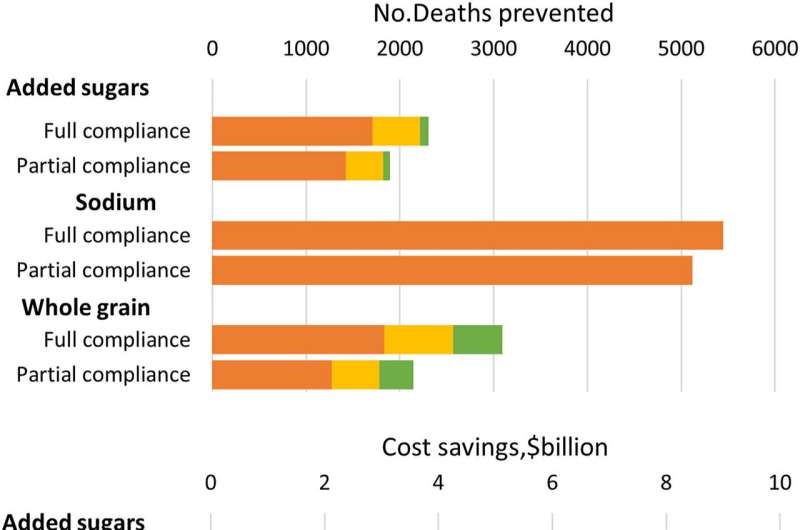This article has been reviewed according to Science X's editorial process and policies. Editors have highlighted the following attributes while ensuring the content's credibility:
fact-checked
peer-reviewed publication
trusted source
proofread
School meals would be even healthier if compliant with US nutrition standards, study finds

Today's school meals are much healthier than they were for the parents of American kids, but still 1 in 4 school meals are of poor nutritional quality. The latest Dietary Guidelines for Americans (DGA), in place for 2020-25, call for meals with less sugar and salt and with more whole grains.
Fully synchronizing school meals with these new standards could positively impact hundreds of thousands of children into their adulthood, with the added benefit of saving billions in lifetime medical costs, investigators from the Friedman School of Nutrition Science and Policy at Tufts University report July 31 in The American Journal of Clinical Nutrition.
By modeling the national implementation of updated school lunch guidelines, the research team found even incomplete compliance by schools would lead to overall reductions in short- and long-term health issues for participating K-12 students.
"On average, school meals are healthier than the food American children consume from any other source including at home, but we're at a critical time to further strengthen their nutrition," says senior author Dariush Mozaffarian, a cardiologist and Jean Mayer Professor of Nutrition at the Friedman School. "Our findings suggest a real positive impact on long-term health and health care costs with even modest updates to the current school meal nutrition standards."
The researchers utilized a simulation model to derive a data-driven estimate of three changes to the school meal program, including limiting percent of energy from added sugar to lower than 10% of total energy per meal, requiring all grain foods to be whole grain, and lowering sodium content to the Chronic Disease Risk Reduction amount for sodium intake in the 2020-2025 DGA.
A portion (35%) of these dietary changes were estimated to continue into adulthood. If all schools fully complied with the new standards, these were estimated to prevent more than 10,600 deaths per year due to fewer diet-related diseases, saving over $19 billion annually in health care-related costs during later adulthood. The worst-case estimate, in which schools remained with their current food offerings, saved a little over half as many lives and health care dollars.
School meals aligning to new dietary guidelines for added sugars, sodium, and whole grains would have modest, but important, short-term health benefits for children. For example, these changes were estimated to reduce elementary and middle school students' body mass index (BMI) by 0.14 and systolic blood pressure by 0.13 mm Hg. Benefits were about half as large for high school students because fewer older students eat school-provided meals.
"Using a comparative risk assessment model, our estimations are based on the best available, nationally representative data on children and adults and the best available evidence on how dietary changes in childhood relate to BMI and blood pressure, how dietary changes persist into adulthood, and how diet influences disease in adulthood," says first author Lu Wang, a postdoctoral fellow at the Friedman School. "Our new results indicate that even small changes to strengthen school nutrition policies can help students live longer, healthier lives."
The study's findings, which cannot prove the outcomes they describe but are derived from a mathematical model based on the best available demographic and health data, are timely given the United States Department of Agriculture's recent commitment to updating the school meal nutrition standards to align with the 2020-2025 dietary guidelines.
The price to fully implement new school meal standards is yet to be determined, but previous alignments suggest it would add at least another $1 billion nationally to the cost of these programs, or only about 5 percent of the total predicted annual long-term health care savings this change would yield.
More information: Lu Wang et al, Evaluation of health and economic effects of United States school meal standards consistent with the 2020–2025 dietary guidelines for Americans, The American Journal of Clinical Nutrition (2023). DOI: 10.1016/j.ajcnut.2023.05.031


















